Nurses spend long hours on their feet, which may result in swollen ankles, tired calves, and aching feet. Solution? Best compression socks for nurses. Compression socks are not just a luxury but a saving necessity. In this blog, we will discuss the top 10 compression socks that every nurse needs in 2025 that keep legs energized, reduce swelling, and improve circulation. Before that, sign up and discover the top high-paying travel nursing jobs on SkillGigs. Let’s dive in!
What are compression socks?
Compression socks are specially designed stockings that apply gentle pressure to the legs and feet. The socks are tighter at the ankle and gradually loosen towards the calf or thigh, which helps in blood circulation and prevents swelling. These socks are commonly used by healthcare workers, athletes, travelers, and people with varicose veins. Some of the benefits of compression socks are:
Benefits of compression socks:
- It prevents swelling in the ankles and feet.
- Offers support for varicose veins.
- It helps in reducing leg fatigue and soreness.
- Lower risk of DVT (deep vein thrombosis)
What nurses should look for in compression socks?
You are staring at your laptop screen and looking at countless brands and varieties of compression socks. Confused and don’t know what to buy? Here is the list of things nurses must consider before buying compression socks.
Compression level(mmHg):
The first thing you should look for is the compression level, which means how much pressure the socks apply to your leg. It is measured in mmHg (millimeters of mercury). Here is the breakdown of compression levels:
Mild (8–15 mmHg): Mild compression socks are ideal for everyday comfort and travel. It helps reduce swelling.
Moderate (15–20 mmHg): These socks are designed for those who spend long hours on their feet or have mild varicose veins. It helps in reducing swelling and improving circulation.
Firm (20–30 mmHg): These socks are designed for moderate varicose veins, post-surgery recovery, and to prevent DVT.
Extra Firm (30–40 mmHg): This compression sock provides maximum compression. Used for severe varicose veins or edema.
Medical/Custom (40–50+ mmHg): These are very strong compression socks that can only be used for serious circulation problems under a doctor’s supervision.
Proper fit or size:
Another thing that nurses should look for while buying compression socks is the proper size. If it is too tight, then it can restrict circulation and cause discomfort. If the socks are too loose, then it is ineffective.
Material and Breathability:
Nurses, when buying compression socks, should check the material and breathability too. Material should be moisture-wicking fabric, with durable elastic, and breathable panels to help with comfort, odor, and durability.
Length and style:
The most commonly used compression socks are knee-high, but some may prefer thigh-high, too. Now, many brands are making compression socks with different colors and styles to meet your personal preferences.

Top compression socks for nurses and travel nurses in 2025
Now you know what to look for when buying compression socks, it is time to list the top 10 compression socks that nurses and travel nurses must have.
Nurse Yard HERO
Compression level: 2030 mmHg
Price: $ 41.99
Features:
- Balanced compression
- Smooth and breathable fabric
- Flexible design
- No slip cuff
PRO Compression ‘MarathonStethoscope Hearts’
Compression level: 2030 mmHg
Price: $35
Features:
- Designed to provide a perfect balance of comfort and support.
- Hundreds of colors and styles for personal preference
- Moisture-wicking, odor-resistant fabric.
- Comfortable and breathable material.
Nurse Mates Medical Compression Knee High
Compression level: 1520 mmHg
Price: $16.50
Features:
- Wide comfort cuff, reinforced toe, and heel.
- Good support
- Balanced compression
Poppy Scrubs Oh Snap!
Compression level: 3040 mmHg
Price: $16.50
Features:
- Breathable and comfortable.
- Compression is best for swelling or varicose veins.
- In different colors and styles.
GoWith Bamboo 2Pair Unisex
Compression level: 15-20 mmHg
Price: $24.90 for 2 pairs
Benefits:
- Breathable with a blend of bamboo material
- Moisture-wicking properties
- Comfortable and good for long shifts and everyday use.
Nurse Mates Bamboo
Compression level: 12-14 mmHg
Price: $13.99
Features:
- Bamboo blend
- Moisture-wicking properties
- Anti-bacterial and great support.
Nurse Yard Original Color Solid
Compression level: 20-30 mmHg
Price: $41.99
Features:
- Flexible design provides comfort.
- Breathable fabric.
- Balanced compression and great fit.
- Stays up with a non-slip cuff.
Comrad Knee-High Compression Socks
Compression level: 15-20 mmHg
Price: $34.00
Features:
- Moisture-wicking nylon
- Tighter in the ankles and looser as it goes up
- All day comfort
PRO Compression Marathon Compression Socks
Compression level: 15 – 20 mmHg
Price: $35
Features:
- Nurse-focused design for comfort.
- Provides firm support.
- Great quality and available in different colors.
Cherokee True Support Women’s
Compression level: 15-20 mmHg
Price: $13.20
Features:
- Silky stretch knitted fabric.
- Soft bamboo fiber.
- Odor-resistant and moisture-wicking.
How to select the perfect size for compression socks?
Choosing the right size and perfect fit is really important when buying compression socks. Measure the narrowest part of your ankle that is just above the ankle, and measure the widest part of your calf. Once you get your measurement, match it to the chart. Every brand has its own size chart.
What compression level (mmHg) is best for 12-hour nursing shifts?
The compression level totally depends on the nurse’s personal preferences, but the most commonly used compression level is 15-20 mmHg. It provides comfort and support during their long shifts.






